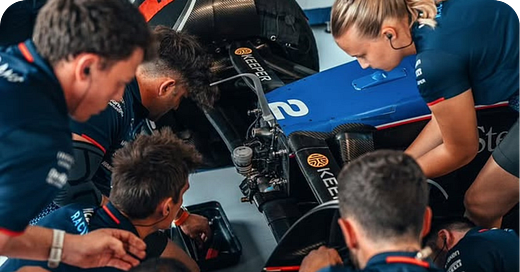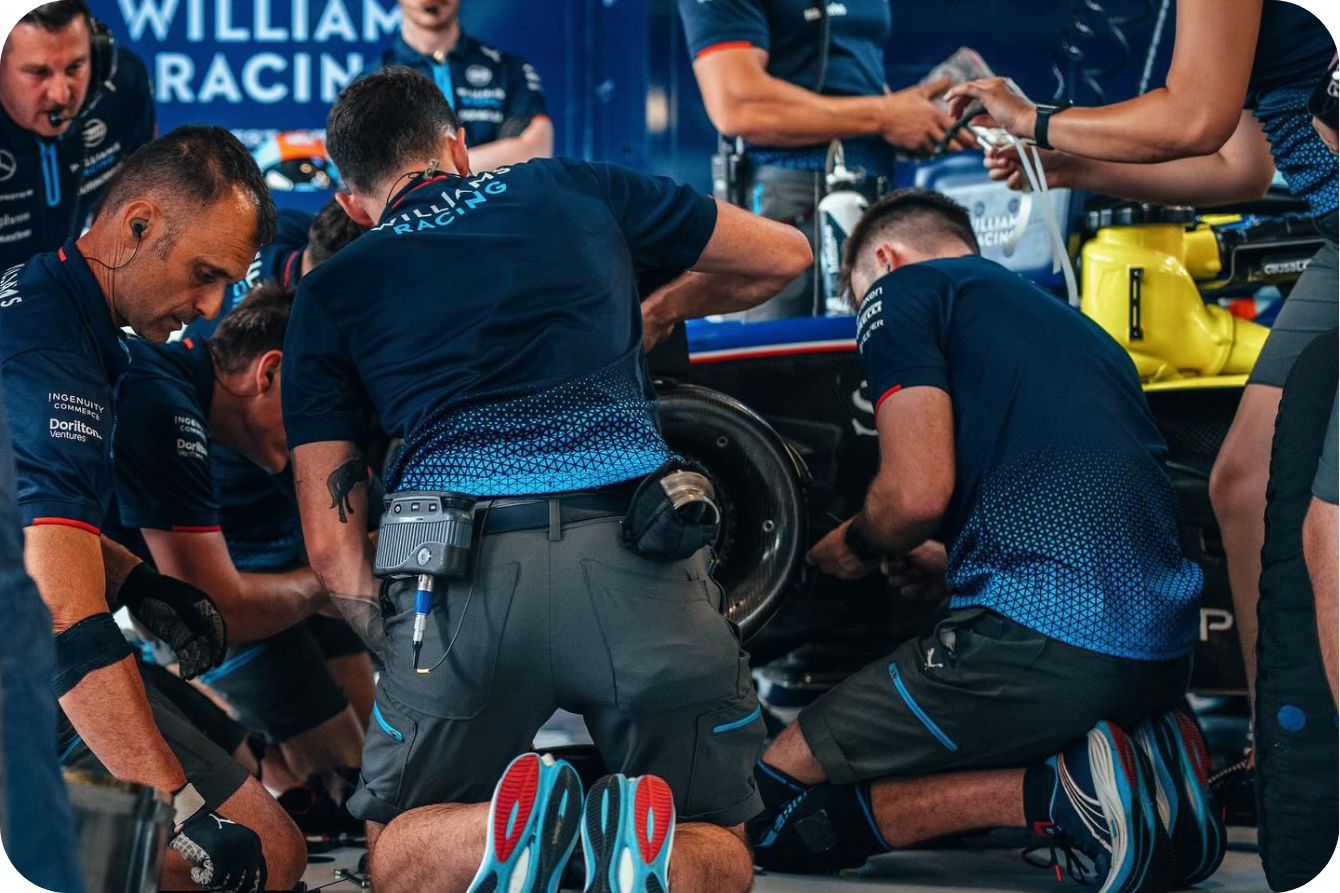The Hidden Hustle of Motorsport's Off-Season
The Work That Shapes a Championship Long Before the Season Begins
Hi there! Welcome to Track Limits, a weekly newsletter where we break down the biggest headlines in F1 and explore the questions, topics, and trends that are shaping the sport. Nothing is off-topic and a little fun is always part of the mix!!
Good evening!! This week, I’m thrilled to introduce our fifth guest writer for Track Limits’ special feature, Beyond Track Limits — a series where we dive into the topics and trends shaping the sport, with the help of experts and amazing insiders!!
In today’s issue, Molly — a motorsport engineer — takes us behind the scenes of the off-season, shedding light on the relentless and intricate intra-team choreography that ensures cars are race-ready when the new season arrives.
We see it at the end of every Formula 1 season, every Sportscar season, IndyCar season, and NASCAR season alike. Fans, friends, and followers wish teams, drivers, engineers, mechanics, and crew a "good off-season," as if the time between the season's end, the handing out of the trophies, and the celebratory parties is a period of calm—a well-deserved break from the relentless travel schedules that see 24 races packed into 30 weeks if you're on a Formula 1 crew, or 36 events squeezed into 39 for those working in NASCAR.
However, racing is a world without a true off-season like the proverbial city that never sleeps. It is a series of constant work, one bleeding into the next. Of course, there are holiday breaks, and some shops close for a week or two around the holidays. Or, crew members and staff might take a well-earned vacation now that they’re not constantly on the road or trotting the globe. But the moment the checkered flag flies in Abu Dhabi, Phoenix, Nashville, or Atlanta, the countdown begins. The focus shifts from celebrating championship results to the next season—often in as little as 90 days. The primary mission? Get a car to the grid, that's ready to perform, ready to win.
Those well wishes for a "good off-season," are typically wrapped in the illusion of leisure, and should be seenas well wishes for maximum productivity, efficiency, and execution. The reality of the off-season is that it is a flurry of activity, cadenced and expertly timed chaos, and engineering: parts must be redesigned and fabricated, chassis updated, garages built out, electronics upgraded, software changed, parts tested on rigs, and components and cars homologated. Even allotted vehicle test days are ramped up after success on the bench or dynamometer, every system must be optimized to ensure peak performance on race day.
Take, for example, Oracle Red Bull Racing’s drawn-out decision about whether to retain Sergio Perez or replace him for the upcoming Formula 1 season. A simple driver decision might seem inconsequential, but for those working on the car, it’s vital. If the team had choosen to replace Checo with Liam Lawson (which they ultimately did), the longer the decision dragged on, the more critical the timing became for those off-season tasks to get completed.
That's due to different drivers having different preferences, which can affect fundamental elements of the car. Such as steering wheel layouts, which would lead to things like wiring harness changes on the electrical side, and even things like seat positions to accommodate body and build. Liam for instance, aligns more closely with Yuki than many realize. They use the same steering wheel configuration, meaning certain setups and systems would require course corrections and changes to the off-season plan.
Data collected over hundreds of hours of racing is scrutinized to identify trends and opportunities for improvement. All to cross the finish line to a checkered flag better than where it ended for the start of their off-season.
Had the decision been pushed forward, with the off-season plan operating under the assumption that Sergio would be in the car. Then the uncertainty alone could have derailed a seamless off-season plan, forcing engineers and mechanics to pivot midstream — wasting precious time and resources the longer the decision remained unresolved and the assumption of Sergio driving the car the primary working plan.
Or take from my vantage point, from my desk—the so-called off-season is anything but restful. For instance, preparations for the 2025 NASCAR Cup Series have been well underway before the 2024 season even wrapped up. New software to accommodate sensors had to be integrated, software updated to align with the governing body's needs, and countless tweaks to the code had to be tested and validated. And then applied to the teams’ rigs and tested for their approval.
All while teams scrambled to build, assemble, and test their new cars, my role demanded meticulous focus on ensuring every system operated flawlessly. Each adjustment, no matter how minor, could mean the difference between a car that performs reliably and one that falls short on race day. I found myself at a conference over the off-season stepping out of a panel to complete something to ensure on-time and correct execution for an item needed by IndyCar.
The level of coordination required during this period is staggering. In Formula 1, teams have to manage cost cap, aero limits, and homologation requirements. The same for the likes of NASCAR and sports cars. Chassis need to be crash-tested and approved by governing bodies, Power unit suppliers are working to tirelessly to extract even the smallest gains in efficiency and performance. Meanwhile, simulation teams crunch terabytes of data to predict how new components will behave under race conditions, allowing engineers to refine designs before physical prototypes even hit the test bench. All the while manufacturing teams and those in the shops are pushing all out to fill the pipeline of parts for homologation, rig testing, and track use.
Fans may not see the behind-the-scenes effort that goes into making their favorite sport possible, but it’s there in every nut, bolt, line of code, layer of carbon, and lap turned in a season.
In NASCAR, the challenges are equally demanding, though unique in their own right. The Next Gen cars, which debuted a few seasons ago, continue to evolve as teams discover new ways to optimize performance within the rules. Adjustments to aerodynamics, suspension setups, and even tire management strategies are ongoing. Colleagues of mine who work on the engine builder side (NASCARs own equivalent to F1 Power Units) have been working 60+ hour weeks between testing and building the engine pipeline for a season that starts in two short weeks.
For engineers, mechanics, and technical staff, the off-season is a time of relentless problem-solving and innovation. It’s also about managing resources to ensure every department is firing on all cylinders. And it’s about balancing short-term objectives, like meeting immediate deadlines, with long-term goals, such as achieving a weight target but not compromising to fail homologation testing or take a loss on track.
The off-season is equally about reflection and learning. For as much preparation work is done physically for a car, there is equally as much done by engineers to analyze aspects of the previous season, dissecting what worked and what didn’t. Where there are weaknesses, can they address them? Data collected over hundreds of hours of racing is scrutinized to identify trends and opportunities for improvement. All to cross the finish line to a checkered flag better than where it ended for the start of their off-season
Fans may not see the behind-the-scenes effort that goes into making their favorite sport possible, but it’s there in every nut, bolt, line of code, layer of carbon, and lap turned in a season. It’s in the early mornings and late nights, the missed events, and the countless sacrifices made by everyone involved. It’s a labor of love, driven by a passion for competition and the pursuit of excellence.
So the next time you wish someone in racing a "good off-season," remember what that truly entails. It’s not always about sipping cocktails on a beach or lounging by the pool. But continuing to work tirelessly to ensure that when the lights go out at the season opener, and a green flag waves, the car is the best it possibly can be. Hundreds and thousands of pieces combined working as one, under a driver's deft hand. The off-season might not be restful, but it is, in its own way, just as exhilarating as the races themselves.
Molly Oxner is a motorsports engineer and content creator passionate about making racing technology accessible to all. By blending her engineering expertise with her love for education and learning, she breaks down complex motorsports concepts. As an engineer who loves working on race cars — and frequently fields questions from her non-engineering friends — Molly believes you don’t need a degree to enjoy, understand, and appreciate the technical side of racing.
When she's not at the race track she co-hosts Braking Bias, a podcast challenging biases in racing, and runs A Bunch of Red Flags, the largest female-led motorsports tech TikTok account. Whether at the track or online, Molly inspires others to embrace the technical side of racing in a fun and engaging way.







